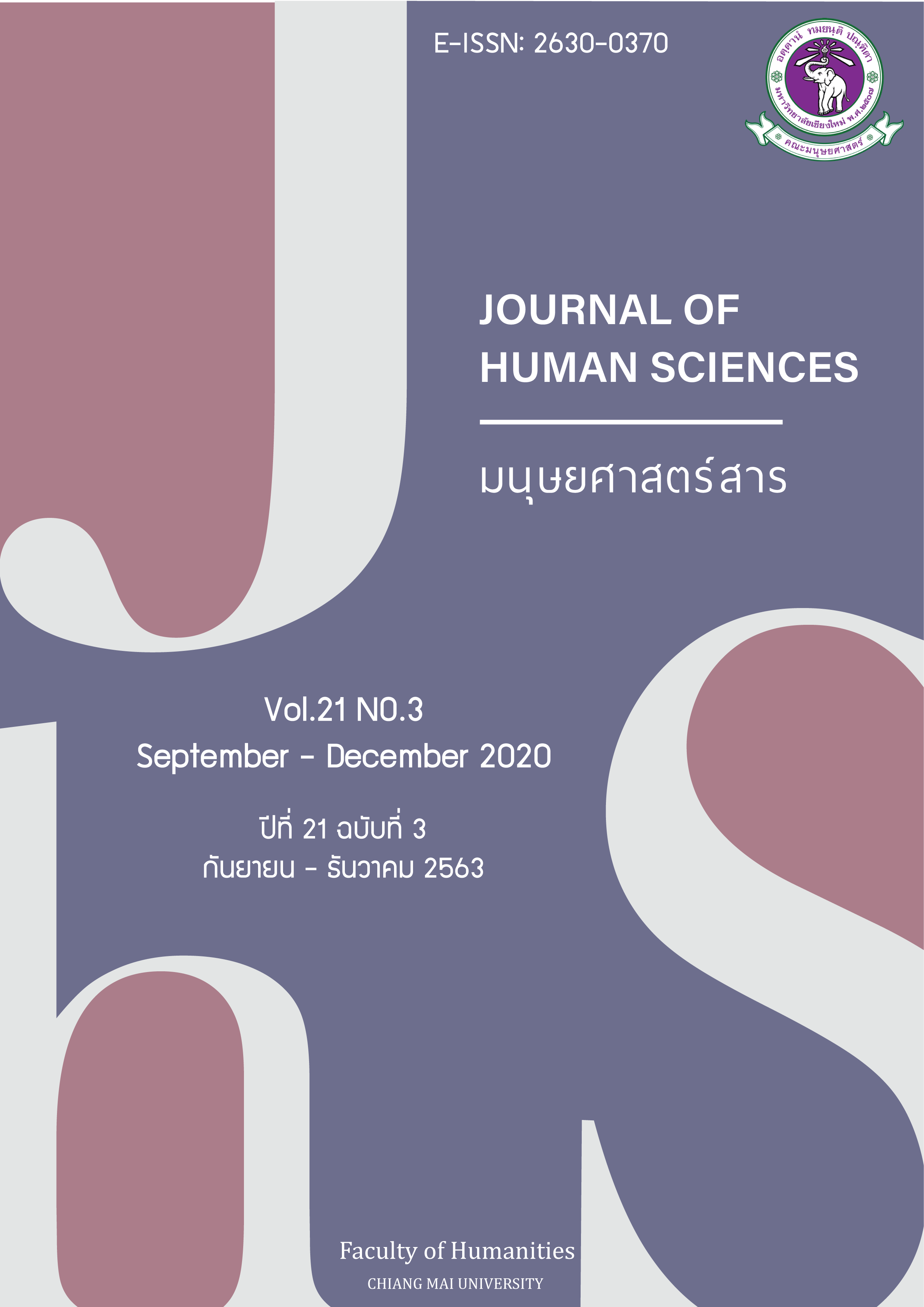ภาพแทนความสัมพันธ์แบบ ‘พหุรัก’ (polyamory) ในสื่อออนไลน์ของไทย
Main Article Content
บทคัดย่อ
บทความนี้มีจุดประสงค์เพื่อศึกษาภาพแทนความสัมพันธ์แบบ “พหุรัก” (polyamory) ที่ปรากฎในสื่อออนไลน์ของไทยจากการใช้ภาษา และศึกษาภาพสะท้อนของสังคมไทยจากภาพแทนที่สื่อออนไลน์ได้ประกอบสร้าง โดยใช้วิธีการศึกษาผ่านการวิเคราะห์ตัวบท (content analysis) ทฤษฎีกำหนดวาระข่าวสาร (agenda-setting theory) และทฤษฎีภาพแทน (theory of representation) แหล่งที่มาของข้อมูลประกอบด้วยสิ่งพิมพ์ของสื่อออนไลน์ของไทย 22 รายการระหว่างเดือนมกราคม 2561 ถึงกุมภาพันธ์ 2563 ผลการวิจัยพบว่ามีการประกอบสร้างภาพแทนความสัมพันธ์แบบมีคนรักหลายคนทั้งในเชิงบวกและเชิงลบ โดยสามารถจัดกลุ่มได้ 7 กลุ่ม ได้แก่ ไม่เกี่ยวข้องกับการมีชู้หรือการมีคนรักหลายคนในรูปแบบอื่น ความซับซ้อน การปฏิวัติวัฒนธรรมทางเพศ ความเบี่ยงเบน ความไม่ซื่อสัตย์และผิดศีลธรรม ทางเลือกของความสัมพันธ์ที่สามารถปฏิบัติได้จริง และดีกว่าความสัมพันธ์รูปแบบอื่น ซึ่งสะท้อนว่าสังคมไทยยังไม่คุ้นชินและไม่ยอมรับรูปแบบความสัมพันธ์ประเภทนี้เนื่องจากยังคงยึดมั่นอยู่กับความสัมพันธ์แบบรักเดียวใจเดียว อีกทั้งยังเชื่อว่าความสัมพันธ์ประเภทนี้ผิดหลักคำสอนของพุทธศาสนาที่คนไทยนับถือเป็นอย่างมาก นอกจากนี้ยังพบว่าสื่อใช้กลวิธีทางภาษา 11 รูปแบบในการประกอบสร้างภาพแทนความสัมพันธ์แบบมีคนรักหลายคน ได้แก่ การเลือกใช้ศัพท์ (การขยายความ การใช้คำกริยา และการใช้คำเรียกขาน) การใช้คำถามเชิงวาทศิลป์ การใช้มูลบท การอ้างถึง การใช้คำอุปมา การปฏิเสธ การใช้ทัศนภาวะ การใช้คำซ้ำ การใช้สุภาษิต การใช้มโนภาพ และการใช้สำนวน โดยสื่อออนไลน์ได้ใช้กลวิธีทางภาษาเหล่านี้เพื่อสร้างและเผยแพร่วาทกรรม และเพื่อโน้มน้าว และชักจูงผู้อ่านให้เชื่อในสิ่งที่สื่อนำเสนอ
Article Details
เอกสารอ้างอิง
Anapol, D. (2010). Polyamory in the twenty-first century: Love and intimacy with multiple partners. Lanham, MD: Rowman & Littlefield.
Antalffy, N. (2011). Polyamory and the media. SCAN: Journal of Media Arts Culture, 8(1). Retrieved from https://www.researchgate.net/publication/216532051_Polyamory_and_the_media.
Baker, P. (2014) Using corpora to analyze gender. London: A&C Black.
BrandThink. (2019, December 7) rak phro̜m kan lai khon pen phrưttikam pakati kho̜ng manut ching rœ? [Is having many lovers at the same time really a normal behavior for humans?]. Retrieved from https://www.facebook.com/brandthink.me/posts/ 2549946671997536/.
Buntanon, P. & Piangbunta, S. (2019). Unmasking ideologies hidden in Thai recreational songs: A critical discourse analysis. (Unpublished bachelor’s thesis, Chiang Mai University)
CatDumb. (2019, January 8). phom aoyu!! num naksưksa asai yu ho ruam kan kap fæn sao thang song khon thæm yang hæppi sut sut [“I’m on top of it!!” A college boy lives with ‘both of his girlfriends’ and is very happy with that]. Retrieved from https://www.catdumb.com/polyamorous-relationship.
Easton, D., & Hardy, J. W. (2009). The ethical slut: A practical guide to polyamory, open relationships, & other adventures. Berkeley, CA: Celestial Arts.
Fongkaew, K., Khruataeng, A., Unsathit, S., Khamphiirathasana, M., Jongwisan, N., Arlunaek, O., & Byrne, J. (2019). “Gay guys are shit-lovers” and “lesbians are obsessed with fingers”: The (mis)representation of LGBTIQ people in Thai news media. Journal of Homosexuality, 66(2), 260-273. doi:10.1080/00918369.2017.1398026
Hall, S. (1997). Representation: Cultural representations and signifying practices. London: Sage.
Hall, S., Hobson, D., Lowe, A., & Willis, P. (Eds.). (1980). Culture, Media, Language. London: Routledge.
Klesse, C. (2011) ‘Notions of love in polyamory – elements in a discourse on multiple loving.’ Laboratorium, 3(2). 4-25.
Koonprapaisit, S. (2019, February 24). mi khukhro̜ng lai khon pen rưang phit khæ nai thammai rao tong mi khukhrong phiang khon dieo [Is it so wrong to have multiple lovers? Why do we have to have only one lover?] [Facebook status update]. Retrieved from https://www.facebook.com/SawarootKoonprapaisit/photos/a.2000699383359976/2081919621904618/?type=3&theater.
Krippendorff, K. (1989). Content analysis. In E. Barnouw, G. Gerbner, W. Schramm, T. L. Worth, & L. Gross (eds.), International encyclopedia of communication (pp. 403-407). NY: Oxford University.
Lerlertyuttitham, P. (2015). Advertising language and persuasion, [Special issue]. MANUSYA, 21. 50-59.
Mackaman, C. (2014). The representation of nonmonogamy on feminist blogs. (Published master’s thesis, The City University of New York).
McCombs, M., & Reynolds, A. (2002). News influence on our pictures of the world. In Media effects (pp. 11-28). London: Routledge.
Miss P. (2018, May 18). Polyamory rak lai khon rotfai mai chonkan [Polyamory: Loving many people without conflicts]. Retrieved from http://www.cleothailand.com/love/ polyamory.html.
Nongpol, A. (2019, January 18). ruchak khwamsamphan bæp Polyamory mi khon rak lai khon phro̜ rao samat toklum rak dai mak kwa nưng khon [Get to know polyamory, ‘having many lovers’ because we can fall in love with more than one person].
Retrieved from https://thestandard.co/polyamory/.
Ongwuttiwat, S. (2019). Linguistic strategies used for ‘talking against’ gossip column on Thai online media: A case study of che wang onlai’s wichan læk gossip column on MTHAI website. Journal of Letters, 18(1). 41-76.
Oxford University. (2019). Deviance. Retrieved from https://www.lexico.com/en/definition/deviance
Phanichtrakul, K., & Jaratjarungkiat, T. (2013). The relationship between language and ideology of male homosexuality in Thai daily newspapers in 2012: A critical discourse analysis (Published master’s thesis, Chulalongkorn University)
Polyamory ≠ cheating. (2019, June 9). Retrieved from https://www.echoooooooooo.co/video/polyamory-cheat
Prachathai. (2018, October 21). maihet pra phet Thai #232 phro̜ rak man sapson [Mai Het Pra Phet Thai #232 Because love is complicated]. Retrieved from https://www.youtube.com/watch?v=dy3GoYBtZYA.
Punwichai, L., & Wonsurawat, W. (2020, February 12). phahu rak - With love with Kamphaka EP.9 [Polylove - With Love with Kamphaka EP.9]. Retrieved from https://thetopics.podbean.com/e/พหุรัก-with-love-with-kamphaka-ep9/
rao sam khon khwamsamphan bæp Polyamory thirak dai mak kwa nưng [Three of us: Polyamorous relationships that allow us to have more than one lover]. (2019).
Retrieved from https://www.brighttv.co.th/lifestyle/เรา-3-คนความสัมพันธ์แบบ-polyamory.
Ritschel, C. (2019, August 2). What is polyamory and how does it work?. Retrieved from https://www.independent.co.uk/life-style/dating/polyamory-meaning-open-relationship-dating-sexuality-louis-theroux-altered-states-a8541506.html.
ruchak Polyamory khwamsamphan rak sut sapson thi kœt khưn ching nai patchuban [Get to know polyamory, the complicated love relationship that happens today]. (2019). Retrieved from https://www.sanook.com/women/135129/.
Schastneva, N. (2016). Representation of LGBT issues in Russian: Mainstream news media (2012-2016). (Published master’s thesis, Örebro University)
Sheff, E. A. (2013, September 9). What polyamory is - and what it is NOT. Retrieved from https://www.psychologytoday.com/us/blog/the-polyamorists-next-door/201309/what-polyamory-is-and-what-it-is-not.
Smith, E. E. (2016, May 20). Monogamy is not “natural” for human beings. Retrieved from https://www.psychologytoday.com/us/blog/not-born-yesterday/201605/monogamy-is-not-natural-human-beings
StolenHeart. (2019, February 25). khopson tham rontua mưa khwam chaochu ko panha kæ phu len laichai [Dating more than one results in having a guilty conscience: When coquetry causes problems for unfaithful game players]. Retrieved from https://gamingdose.com/feature/คบซ้อนทำร้อนตัว-เมื่อคว/.
Thongthai, K. (2019, October 10). mong khwamsamphan POLYAMORY chak SENSE8 [Polyamorous relationships: A case study from SENSE8]. Retrieved from http://thewmtd.com/sense8-polyamory/.
V.yada. (2019). Polyamory: rak sam mai sao khong rao sam khon [Polyamory: A pleasant love triangle of us three]. Retrieved from https://rabbitfinance.com/blog/what-is-polyamory
Workpoint News. (2018, September 17). phon wichai phœi Polyamorous phưngpho̜chai nai rak lai khon yangyưn kwa kan yưt tit rak diaochai dieo [Research finds that polyamory (satisfaction in loving multiple people) lasts longer than sticking to monogamy]. Retrieved from https://workpointnews.com/2018/09/17ผลวิจัยเผย-polyamorous-พึงพอใจในร/.
Yodhong, C. (2019a, August 6). kanmi yu khong phua dieo lai mia nai Thai: seriphap thima phrom amnat nai yuk prachathipatai thoi chom [Existence of ‘polygyny’ in Thailand: Freedom that comes with power during the democratic backsliding era]. Retrieved from https://thematter.co/thinkers/polyamory-in-thai-democracy/82126.
Yodhong, C. (2019b, August 30). “POLYAMORY” mưa khwam lai phua lai mia ma chœ kap khwamlaklai thang phet [When polyamory meets LGBTQ+]. Retrieved from https://spectrumth.com/2019/08/30/polyamory-เมื่อความหลายผัวหลา/.


